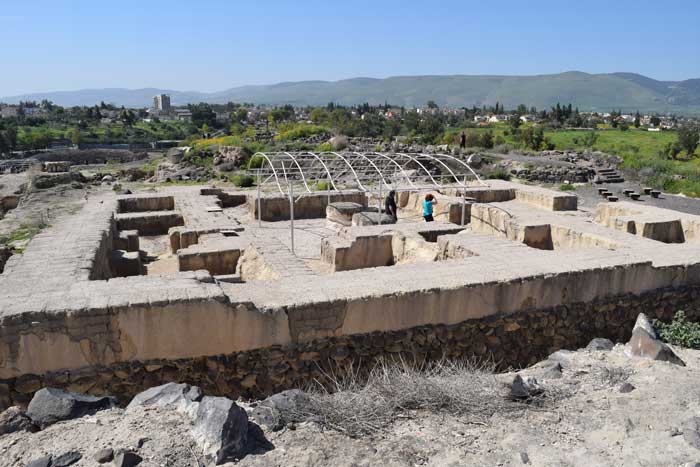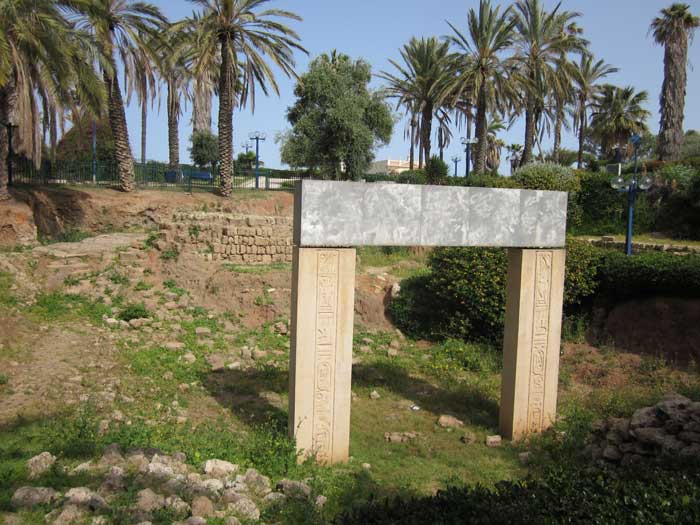
ISRAEL PHOTOS VI -- ISRAEL REVISITED |
Ancient Egypt in Israel

At Beth Shean is a partial 12th century BCE Egyptian governor's house. Inscriptions from the reigns of Seti I (c. 1290-1279 BCE) and Ramesses II (c. 1279–1213 BCE) were found at Beth Shean near the southern edge of Galilee. A statue of Ramesses III (c. 1186-1155 BCE) was also uncovered at Beth Shean. Egypt departed from the site during the century of Ramesses III.

Near the highest point of Joppa/Yafo are the remains of a
fort constructed during the reign of Ramesses II (c. 1279–1213 BCE).
It is 150 miles from Egypt west of the Suez across the Sinai
to Gaza. Egypt ruled Canaan during various intervals between 1500-1100
BCE. The first written record of Israel was from a stele recorded during
the reign of Merneptah (c. 1213-1204 BCE) stating Merneptah had conquered
Ashkelon, Gezer, Yanoam and Israel.
The Bible does not mention Israel encountering Merneptah, nor that Egypt
once ruled in Canaan. The area was not heavily populated during Egyptian
rule. There were Egyptian accounts of numerous military campaigns
resulting in the gain of many slaves and much wealth being taken back to
Egypt. The ancient Egyptians circumcised their boys during adolescence. It
is likely the early Hebrews were also influenced by other aspects of
Egyptian life.
The Egyptians left epitah inscriptions in their tombs noting their
accomplishments and
funerary offering instructions. The priests of Egypt embalmed the dead
wrapping them in linen strips and mummified them. The mortuary priests
presented offerings of bread, beer and other essentials for the dead. The
wealthy rulers had their pyramids packed full of essential items for the
afterlife as was discovered at King Tut's tomb. The priests taught them
offerings were necessary for them to reach existence after death. There
was much deception and mythology in this system. Great quantities of
wealth were transferred to the priests who claimed to have the power to
intercede for a person after death. Ramesses III transferred huge sums of
commodities, lands, precious metals and manufactured items to the priestly
establishment as recorded in the Harris papyrus.
From early times a few had a greater sense of moral obligation. Some
people had parts of their good deeds recorded in their tombs. It seemed
more important to them than mentioning their offerings to the
priests.
Harkuf's tomb epitaph (before 2000 BCE):
'I came from my city. I descended from my nome. I built a house. I set up
the doors. I dug a lake and I planted trees. The king praised me. My
father made a will for me. I was
excellent (beloved by) his father, praised by his mother, whom all his
brothers loved. I gave bread to the hungry and clothing to the naked. I
ferried him who had no boat.'
(Ancient Records of Egypt, Vol. I, Breasted, 1906)
Home Page
Nazareth Cliff
Cliff Survey
Cliff Cross Section
Gennesareth
Magdala
Old Tiberias
Sea of Galilee Fishing
Nain
Caesarea
Egypt in Ancient Israel
Khirbet Qeiyafa
Siloam
Written by David Q. Hall dqhall59@yahoo.com
May use photos and text for non-profit publication. For profit usage subject to approval.